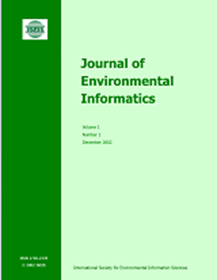利用气象资料估算森林叶面积指数:启发式模型的评价
IF 5.4
1区 环境科学与生态学
Q1 ENVIRONMENTAL SCIENCES
引用次数: 9
摘要
叶面积指数(Leaf Area Index, LAI)是影响地表与上覆大气之间能量、碳和水交换的重要结构特征。利用遥感地表反射率数据,通过回归、启发式数据驱动和辐射传输模型获得了全球尺度的LAI数据集。然而,利用遥感数据估算LAI仅限于晴空条件。此外,采用传统的多光谱遥感影像分析方法估算森林LAI也存在问题。针对上述遥感数据估算LAI的不足,本研究采用基因表达编程(Gene Expression Programming, GEP)技术从气象数据中获取LAI。在美国不同的阔叶树和针叶树样地对新方法进行了试验。结果表明,GEP技术能较准确地估算不同立地气象资料的LAI。本文章由计算机程序翻译,如有差异,请以英文原文为准。
Estimation of Forest Leaf Area Index Using Meteorological Data: Assessment of Heuristic Models
Leaf Area Index (LAI) is an important structural feature of our ecosystem as it affects energy, carbon, and water exchanges between the land surface and overlying atmosphere. Global scale LAI datasets have been obtained by regression, heuristic data driven, and radiative transfer models using remotely sensed land surface reflectance data. However, the estimation of LAI from remotely sensed data is limited only to clear sky conditions. Also, it is problematic to estimate LAI in forests by using conventional remote sensing image analysis of multi-spectral data. Due to the above-mentioned shortcomings of estimating LAI from remotely sensed data, this study obtained LAI from meteorological data using the Gene Expression Programming (GEP) technique. The new approach was tested in different forest sites with broad-leaf and needle-leaf trees in USA. The results showed that the GEP technique can accurately estimate LAI from meteorological data in different forest sites.
求助全文
通过发布文献求助,成功后即可免费获取论文全文。
去求助
来源期刊

Journal of Environmental Informatics
ENVIRONMENTAL SCIENCES-
CiteScore
12.40
自引率
2.90%
发文量
7
审稿时长
24 months
期刊介绍:
Journal of Environmental Informatics (JEI) is an international, peer-reviewed, and interdisciplinary publication designed to foster research innovation and discovery on basic science and information technology for addressing various environmental problems. The journal aims to motivate and enhance the integration of science and technology to help develop sustainable solutions that are consensus-oriented, risk-informed, scientifically-based and cost-effective. JEI serves researchers, educators and practitioners who are interested in theoretical and/or applied aspects of environmental science, regardless of disciplinary boundaries. The topics addressed by the journal include:
- Planning of energy, environmental and ecological management systems
- Simulation, optimization and Environmental decision support
- Environmental geomatics - GIS, RS and other spatial information technologies
- Informatics for environmental chemistry and biochemistry
- Environmental applications of functional materials
- Environmental phenomena at atomic, molecular and macromolecular scales
- Modeling of chemical, biological and environmental processes
- Modeling of biotechnological systems for enhanced pollution mitigation
- Computer graphics and visualization for environmental decision support
- Artificial intelligence and expert systems for environmental applications
- Environmental statistics and risk analysis
- Climate modeling, downscaling, impact assessment, and adaptation planning
- Other areas of environmental systems science and information technology.
 求助内容:
求助内容: 应助结果提醒方式:
应助结果提醒方式:


